Remaking Future Worlds: Possibilities from Cultures of Science and Technology
Paul Michael Leonardo Atienza
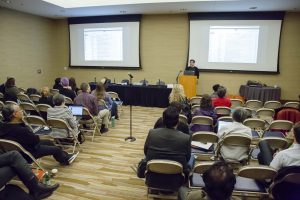
The sesquicentennial of the University of Illinois provided an opportunity to examine the role of the public university in generating technological promises. Do today’s promises of innovation demonstrate lessons learned from past attempts to improve society through technology? What may be branded as new and innovative may still have built-in biases left intact from previous aspirations of what technology and science could offer society.
Participants in Technocultural Futurisms: Code, Hack, Move identified and discussed the beneficiaries of the public good and featured voices that have previously been left unheard. The speakers addressed the contemporary demands of a planet in crisis. They provided critical perspectives on how science and technology shape an optimistic view of the future for some while also creating suffering, death, and violence for others in the present.
The organizers of Technocultural Futurisms defined as “futurisms” the many artistic and political movements that challenge current social norms and imagine different futures. Approaching technology and science as deeply linked with culture, they organized the day’s presentations according to three concepts that brought together the arts, humanities, and sciences—code, hack, and move. The symposium organizers offered an argument for how these concepts manage how we speak, understand, and feel technological innovations in the processes of sensemaking and relating to one another in our ever-changing and seemingly hyper-connected planet.
The scholars of Technocultural Futurisms demonstrated the conviction that reflection on the future requires acknowledgment of the past and present; moments of commemoration come with aspects of history we often want to forget. During her opening address, Professor Susan Koshy explained how one hundred and fifty years ago, the University of Illinois emerged from state-led acts of technocultural futurism. The Morrill Act that transformed public land into the University of Illinois campus came from revolutionary minds that dreamed of technical and agricultural education for United States citizens. The nation acquired these lands through the violent expulsion of Native nations under provisions such as the Indian Removal Act. Such expulsion and removal made room for the Morrill Act to designate the land on which this university stands as for the public good—though in this case, “public” referred to anyone but the indigenous who had historical and legal claims to these lands. It is important to recognize the people of this land before moving forward with accounts from Technocultural Futurisms:
The Chickasaw, the Ho-Chunk, the Fox, the Kaskaskia, the Kickapoo, the Mascouten, the Miami, the Piankeshaw, the Peoria, the Potawatomi, the Sauk, the Shawnee, and the Wea who descended from the civilization who built and lived in Cahokia, all still exist within and beyond the borders of the United States, a settler state.
Coding the Future
The first of three panels focused on the concept of code. In communication and information processes, code may mean a set of rules that translate information from one form to another. The transformation of information into code often results in simplifying information in order to help it circulate or to allow it to be stored easily. Code translates and interprets our complex and messy worlds into plain and clean versions of itself. The presenters’ research topics demonstrated how technologies presented as an easy fix to social problems cover up problematic histories and unintended effects.
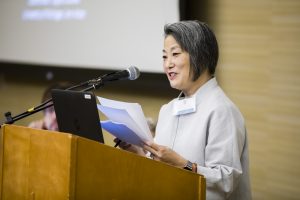
In “The Racial Empathy Machine: Discourses of Virtual Reality After Trump,” Professor Lisa Nakamura focused on virtual reality (VR) and argued against current perspectives from digital industries that promote these computer-generated simulation experiences as a way to correct racist thoughts and develop racial empathy among users. Nakamura reminded us that VR is not new technology. Its emergence in the early 1990s failed to generate successful profits when introduced to the market. According to Nakamura, the current social atmosphere during Trump’s U.S. presidency provides an opportunity for VR businesses to demonstrate how their machine does something good. She explained that limitations in the design and conception of virtual reality place too much faith in claims that digital self-creation alone provides a way to work through social ills, with the hope of equality for all.
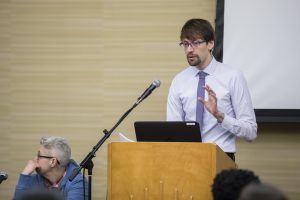
Following Nakamura, Professor Patrick Jagoda’s presentation focused on the social and technological impact of digital games. “Videogame World, Future Hypotheses” examined gamification as it developed from different academic fields such as behavioral economics and design culture. Gamification is the use of different aspects of game design such as competition, repetition, and completion of strategic tasks. He argued that components of games have changed how companies, governments, and people conceive themselves as competitive entities. They emphasized specific forms of motivation as a success, the qualities of an ideal individual, and a worldview. Furthermore, Jagoda explained that a shift from psychological to philosophical perspectives in problem-solving in game design led to standardized procedures in hypothesis formation. But, perhaps solutions are not what games should focus on. Jagoda emphasized the blend of art and science experimentation that moves away from the idea that people could master the world and instead learn from problems that may not have solutions. Play and imagination may be among the 21st century’s most important cultural tasks, bringing the potential for reinvigorating the worlds we live in.
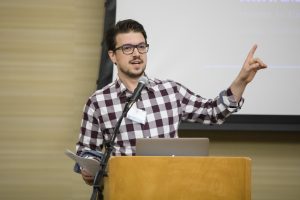
The final presenter in the panel emphasized the role of technology studies scholarship in the ongoing erasure of indigenous people and their cultures. Professor David Gaertner shared the digital work of Cree artist Kevin Lee Burton. In “A ‘Landless Territory’?: God’s Lake Narrows and the Spatial Turn in Indigenous Open Access,” Gaertner argued that Burton’s artistic work translates the physical spaces of the Indian reserve, God’s Lake Narrows, into a virtual place that highlights significant contributions that indigenous people make and continue to make with technology. Gaertner added that the online site reimagines open access of knowledge in cyberspaces into a form that respects the position of indigenous people in their resistance to free sharing of their cultural information. The intentional creation and organization of this online site reimagines knowledge-sharing and open access away from immediate attainment and into relational and contextual forms of exchange.
Hacking the Future
The second panel centered on the notion of “hacking.” Dominant stereotypes of the hacker in popular media depict this figure as a socially awkward young man who is highly skilled in computer programming and uses his technological prowess toward malicious purposes. As a noun, a hack is also a creative, clever improvisation toward the enhancement of something. The three artists/researchers that brought the panel theme to life described their creative projects addressing multiple issues related to technology, surveillance, privacy, and planetary health. As a methodology “hacking the future” may not dismantle technology’s drive to control every aspect of our lives, but it disrupts and plays with our relationships with technoscience.
Barcelona-based artist Joana Moll emphasized the invisible infrastructure that makes up the internet. Opening with an image of a smoke cloud encased in a glass box, Moll explained that as people use the internet more and generate more data, it becomes more invisible. From the miles of cable that crisscross under the world’s oceans to multiple satellites orbiting above Earth’s atmosphere, the internet is big and messy. Moll’s presentation stressed the importance of understanding the sheer amount of data produced in the use of internet technologies, an amount that ultimately defies measurement.
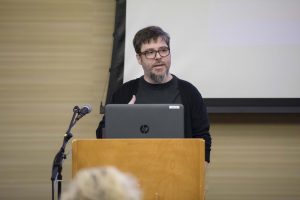
Professor Ben Grosser followed with creative experiments in the examination of cultures of software. His artworks investigate how programmed automation and data collection from everyday human interactions on various internet-based media platforms like email or social networking sites produce hopes and fears among its users. Grosser concluded that surveillance capitalism among internet-based technologies and platforms is a complex industry. The tracking of our every move and measurement becomes a commodity to be sold. Critical design alone may not be enough to address such an expansive problem. A strategy of confusing automated data collection programs is his preferred artistic research method in interrogating the cultural effects of software.

The final speaker of the panel was Los Angeles- and Brooklyn-based artist Lauren McCarthy. McCarthy uses multiple media forms such as performance, video, and software in addressing questions about surveillance and tracking information such as locations and behaviors. McCarthy shared several creative projects that addressed increased human dependency on machines in the tracking of everyday tasks and emotions. Her pieces questioned new forms of transactional relationships among people mediated through online technologies.
The panelists’ aim was to raise awareness of how digital media are designed not just for communication and entertainment. Through their critical research and creative experiments, each artist highlighted shifts in the way media technologies are changing people’s notions of privacy and social accountability. When reliance on machine assistance in ordering and programming daily tasks continues to become a social norm, these artists provided ways to work with and critique technology’s influence in our everyday lives.
Moving the Future
The final group of presenters took the most liberty in interpreting the concept of move in their themes and topics. For these scholars, moving the future meant simultaneously reimagining the past and the present. From fearless art making to an examination of migrant programmers in Bangalore, and a reconsideration of the development of technological objects, the last group of scholars challenged how technocultural solutions of our present time contribute to precarious life and an empty promise of utopian futures.
In “#FearlessGestures: In the Ruins Yet to Come,” Ricardo Dominguez related a history of resistance in the form of artmaking. He explained that he reminds his students that an artist’s job is not to manage an archive, but instead to imagine work in the ruins yet to come. This requires creating vocabularies, patterns of visualization, and cross-border relationships that disturb the “future now.” He added that movement and flow come in various speeds and different directions; thus solutions in re-imagining futures must come in many forms.
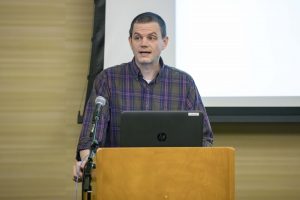
Professor Alexander Galloway’s “From One to Two” presented on how old techniques of ancient textile weaving contributed to a process of discretization in society, the way in which the one becomes the two. Such incremental transitions in technological innovation demonstrated cultural changes that led to computational breakthroughs later in the century. Early uses of technology were crucial experiments that require further attention and analysis within the field of technology studies. Attention to such objects from early computing stands to expand historical, conceptual, and thematic views into our definition and approach to the digital.

Based on eight years of fieldwork in Bangalore, India, Professor Nishant Shah’s presentation focused on the development of a migrant programming labor force. These digital information technology workers or “techies” became a new citizen class in India. Never completely considered residents, techies foster a specific lifestyle generated from their expertise and their movement from work assignments locally and around the world. Shah explained that techies are able to escape India’s social stereotypes because of their opportunities to work outside of the country. This freedom of movement allowed these laborers to reinvent themselves. But for Shah, aspirations that technology industries may provide new possibilities and opportunities fall short.
Using the concept of information overload, Shah demonstrated that the lives of techies became unmanageable after their return to India and that a path toward a promising future may not always be fulfilled.
Keynote Address—The Social Life of DNA: Racial Reconciliation and Institutional Morality
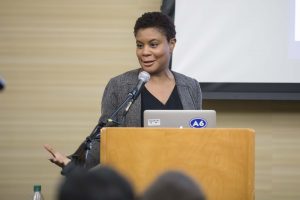
Professor Alondra Nelson concluded the first day of Technocultural Futurisms with a presentation about the social and technical possibilities of DNA testing among African Americans. Nelson asked if the science of genetic ancestry could be a “reconciliation project” or a way to correct the social and institutional injuries caused by the violence of slavery in the United States.
According to Nelson, DNA offers a link to black history. Her main case study focused on the recent use of genetic ancestry testing among descendants of nearly three hundred enslaved men and women with ties to Georgetown University. The educational institution’s Jesuit stewards sold these men and women to Southern plantations in 1838 in order to maintain its assets and to pay its debts. The current administration acknowledged the school’s past and developed policies to provide preferential admission to the descendants of the enslaved people. Along with the admissions policy, the school created a memorial, established an Institute of Slavery and Its Legacy, and changed the names of two buildings that bore the presidents who approved the sale of those people.
Nelson pressed Technocultural Futurisms participants to continue questioning technoscientific processes. She clarified that she trusted science and technology, but that we must understand the social contexts that uphold inequalities and prefer certain types of people over others. She concluded with a quote from Didier Fassin’s At the Heart of the State about the morality of social justice and transformation. “Moral economics,” wrote Fassin, “…are connected in the daily activities of institutions through the values and effects which crystallize around social issues and the responses that are given in concrete situations.” Nelson proposed the term “trans-scientific” to denote questions which can be asked of science and yet which cannot be answered by science. Through her examples, Nelson argued that the promise of science and technology in addressing social and historical traumas require further refinement.
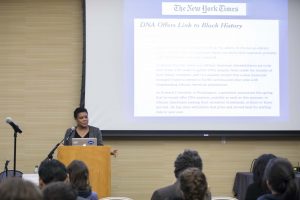
Coda: Imagining a Future for the Collaborative for the Critical Study of Technology
In a concluding session on the symposium’s second day, Professor Alondra Nelson commented how such interdisciplinary formations like the collaborative relationship among the faculty invested in the critical study of technology is a strength of the University of Illinois that cannot be found anywhere else. She added that such a blend of arts, technical sophistication, humanities, and social sciences is powerful. It requires administrative support and infrastructure in order for this dynamic arrangement to redefine what it means to be a STEM campus.
Professor Nishant Shah added that we should invest in changing the institution. This may come in different forms and knowledge partnerships. We must trust that we know what we are doing and make it accessible to as many broad publics as possible.
Technocultural futurisms acknowledge that the past matters. We are canny translators. We rethink processes. We imagine different configurations that grapple with histories of success and failure. Our futures may be in ruin, but through collaborative relationships, we can design more thoughtful, sustainable options that advance technology, science, culture, and society in the mutual habitation of our shared worlds.



